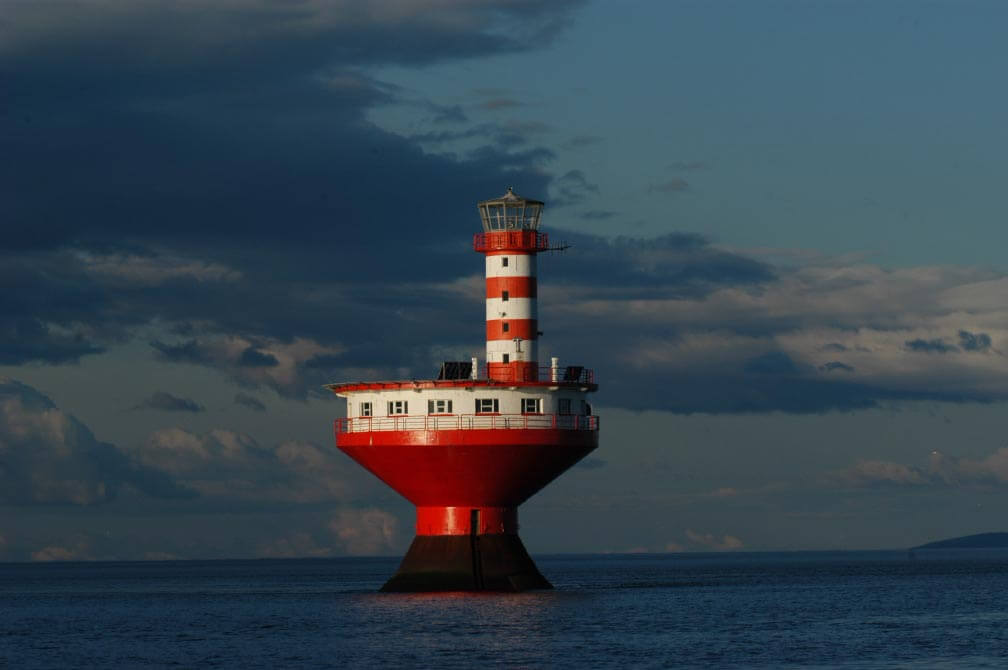When we speak of the St. Lawrence, we often hear the terms “Estuary” and “Gulf”. What do they mean? Where does the Estuary end and the Gulf begin?
The St. Lawrence River originates in the Great Lakes on the border between Canada and the United States. Stretching 2,000 km (excluding the Great Lakes), the watercourse is divided into three sectors: the River, the Estuary and the Gulf. The Saint-Lawrence alone collects 1% of the rainwater that falls on the planet. Tides begin to be observable from Lac Saint-Pierre, just before Trois-Rivières.
Estuary
The Estuary begins at Île d’Orléans, where salt water from the ocean mixes with the fresh water of the river. As the density of salt water is not the same as that of fresh water, two layers of water are created. The water reaches full salinity at the head of the Laurentian Channel, near Tadoussac. The abrupt rise in the Channel’s seabed produces significant upward flows of cool water that mixes with the more temperate surface waters. Driven against the current from the Atlantic toward the Gulf of St. Lawrence, deep salt water is pushed up to the surface by the Gaspé current and the influence of the tides. This phenomenon is called upwelling, and the result is a dazzling array of marine life. The St. Lawrence Estuary is one of the largest and deepest estuaries on the planet.
| The Saint-Lawrence | Fluvial Sector | Estuary Sector | Gulf Sector |
| Width | 1 to 5 km | 2 à 60 km | over 300 km |
| Depth | 2 to 20 m | over 300 m | approx. 500 m |
| Salinity | Non-saline | Increasingly saline; full salinity start. at Tadoussac | Saline |
| Start | Great Lakes | Ile d’Orléans | Pointe-des-Monts |
| End | Ile d’Orléans | Pointe-des-Monts | Atlantic Ocean |
Gulf
The Gulf begins at Pointe-des-Monts, where the river widens into an inland sea that opens out into the Atlantic via the Cabot Strait, (south of the island of Newfoundland) and the Strait of Belle Isle (north of Newfoundland).
Are some whales better suited to live in the Estuary or in the Gulf?
The answer depends on several factors, but one in particular: diet. Other than belugas, which are year-round residents of the St. Lawrence, whales are visitors to the Gulf and the Estuary. They come here in pursuit of their favourite prey and especially to find large concentrations of food. Owing to its tides, the meeting of currents and the bathymetry (underwater relief) along the North Shore, the Estuary is rich in krill and capelin, which provide a feast for rorquals.
Sperm whales take advantage of the deep waters of the Laurentian Channel to feed on medium-sized squid, one of their favourite prey.
Belugas on the other hand remain mainly in the Estuary (and sometimes in the gulf), where they are found year round. In winter, ice cover is heavier here than in the Gulf and protects them from the extremely rough winter seas. However, in some of the Estuary’s downstream sectors such as Tadoussac, a polynya (absence of ice) is created due to rising warmer waters.
Other species such as the Atlantic white-sided dolphin have a preference for the Gulf. Favouring offshore waters, the white-sided dolphin sometimes gathers in herds numbering in the thousands.






